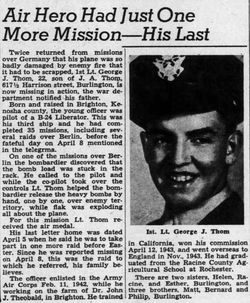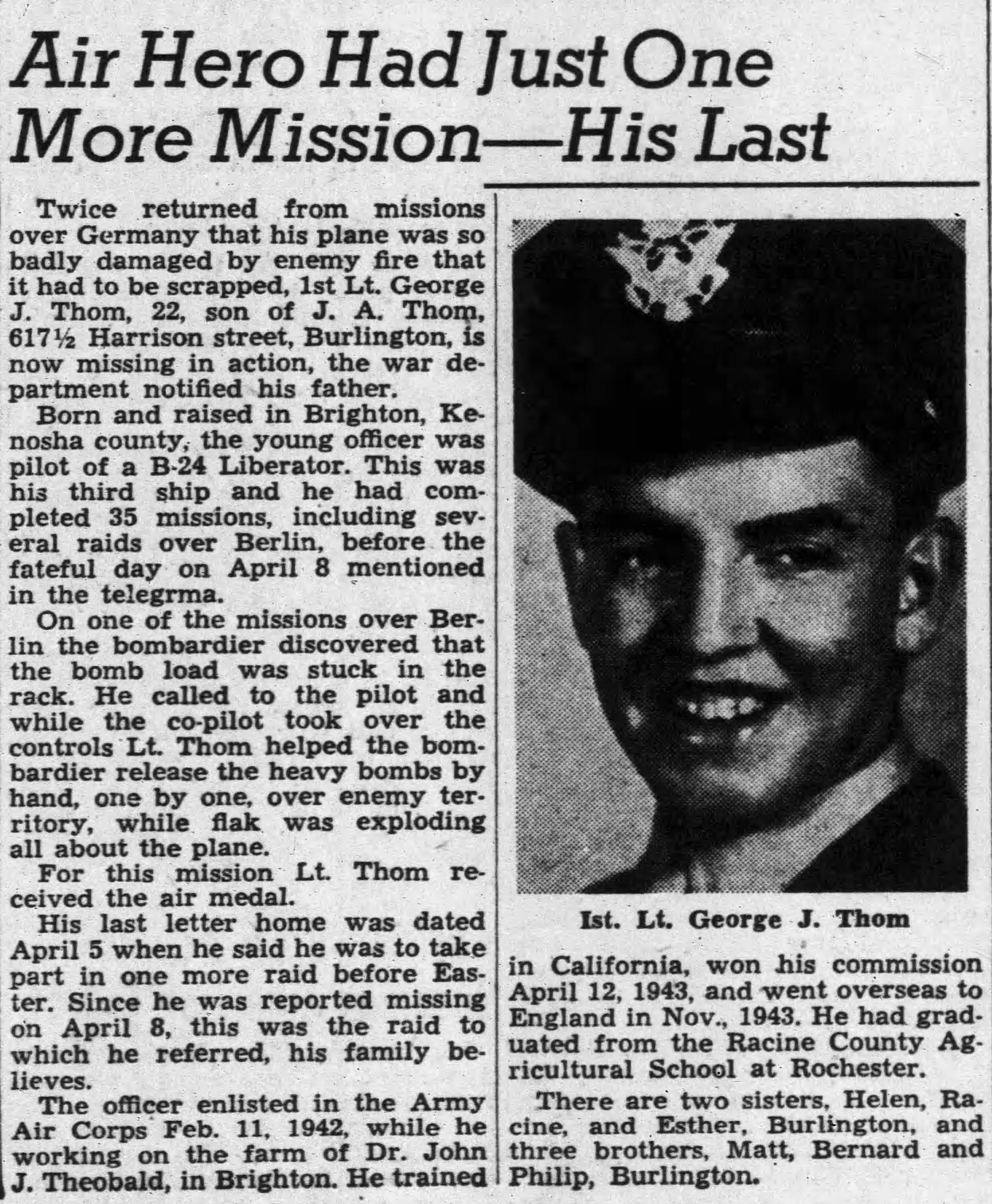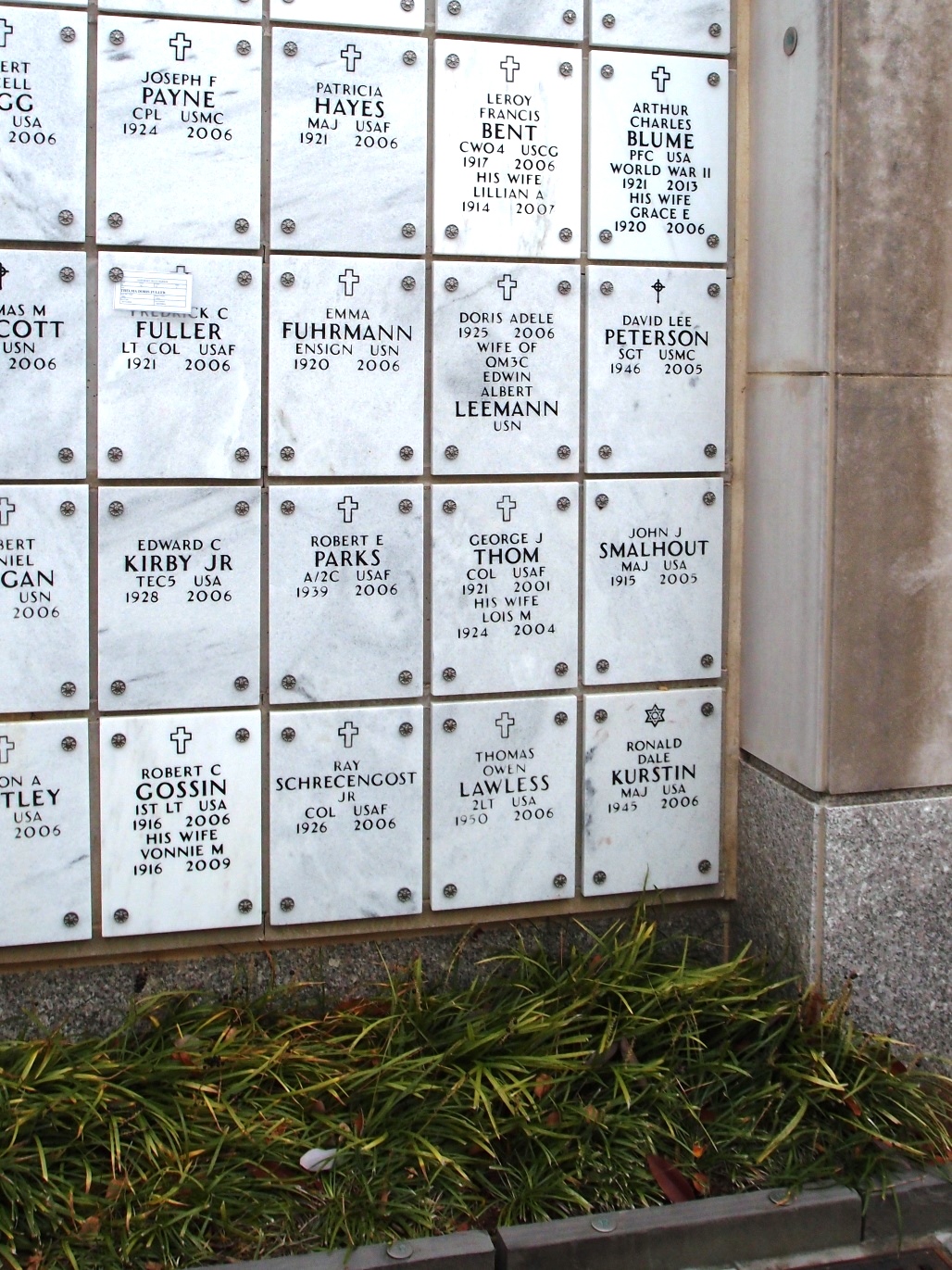Pilot 1st/Lt. George J. Thom WIA/POW
Hometown: Burlington, Wisconsin
Squadron: 67th 44th Bomb Group
Service#
Awards:
MACR #3849
Target: Airdrome, Langenhagen, Germany
Mission Date: 8-Apr-44
Serial Number: #42-7767
Aircraft Model B-24
Aircraft Letter: C-Bar
Aircraft Name: SHACK RABBIT
Location: suburbs of Hannover
Cause:Enemy aircraft
Crew of 10 POW
The month of April cost more plane losses and casualties of the entire war so far as the 44th Bomb Group was concerned! More so than the August 1943 disasters of Ploesti and a later mission to Foggia, Italy. The 8th of April was the worst single day. For the first time in the war, the 44th BG was led by 389th BG aircraft equipped with PFF(Pathfinder equipment). With them as Command Pilots were Col. Gibson, Group C.O., and Captain Robert Lehnhausen, 68th Squadron C.O. They flew with 389th Bomb Group personnel and airplanes. It was not a successful endeavor. The primary target, Brunswick, as well as the secondary were obscured by a successful smoke screen, so a target of opportunity, Langenhagen Airdrome, was bombed instead. Enemy aircraft attacks were numerous and severe, with our gunners claiming 12 destroyed, 6 probables and 1 damaged. But the 44th Bomb Group’s formation was subjected to concentrated attacks and lost a total of eleven aircraft! This, compared to the nineteen other B-24s lost by all other Groups. This was the worst loss of the war for one mission by the “Flying Eightballs”.
The second 67th Squadron aircraft lost was that piloted by 1st Lt. George J. Thom. The MACR briefly states that this aircraft is believed to be the one that exploded after being hit by enemy aircraft and that no chutes were seen. (Time: 1347, in the vicinity of Salzwedel.) However this cannot be correct as George Thom rode this aircraft nearly to the ground and everyone else had time to bail out. 1st Lt. Gerald G. Gille, navigator on this crew, gave me his story, “On the early morning of April 8th, 1944 I was awakened and asked if I would like to volunteer for the navigator’s; job, flying with the ‘foreign’ 67th Squadron. Being one mission behind my regular crew, I consented, and found myself with Lt. Thom’s crew after breakfast. Our mission was to Brunswick with a direct route through ‘Flak Alley’. “After assembly in the air, and crossing the European coast, I noticed we were having trouble keeping in formation. I always thought we should have aborted, but Lt. Thom was making every effort to keep up. Upon entering Germany, we were straggling badly, and sure enough, Me 109 enemy aircraft were attacking between eleven and one o’clock, high. “It seemed as though they were about 10 abreast. The first pass they crippled two of our engines. Now we were really far behind our formation. On the second pass, they shot out the far left (#1)engine and our electrical system, and the remaining left engine, #2, was smoking. A 20-mm shell exploded just under the nose turret and blew out the nose wheel tire and covering. The bombsight also got a direct hit, saving my life, I believe, as only my right ankle caught the fragments. “This all started at approximately 21,000 feet. After helping to get the bombardier (Alcott) out of the nose turret, I stood up and looked out the astrodome to see Lt. Thom motioning for us to bail out. We were in a flat spin, and after watching the altimeter slowly winding down, I checked my chute straps, zipped my leather jacket closed, after making sure I had escape rations. I decided to forget about my flight cap, checked the altimeter again – it was at 6,000 feet – stood up and looked out the nose astrodome again and saw no one left, and got ready to jump. The last reading on the altimeter was 1500 feet when I dived out the missing nose door head first. “We were in the suburbs of Hannover when the plane crashed and exploded. (So the MACR data was incorrect) I found myself landing in a two acre plowed field with a sprained, wounded right ankle, with blood running out of my G.I. boot. I was gathering my parachute together when a German soldier on a motorcycle came to me off the road, into the field where I was. He jumped off his motorcycle and pointed his rifle at me, yelling, ‘Pistol? Pistol?’ I said ‘Nein’ and offered him some chewing gum, which he declined. “I tried to explain to him about my damaged ankle and that it was hard for me to walk. But he forced me to carry my gathered parachute down the road approximately one-half a mile to a flak tower. Then I was able to sit down on the mound levee around the flak gun. Several of our crew’s sergeants soon were captured and brought to this same assemblage where I found out all of the crew got out safely!” Left waist gunner, Loyes Knotts, added a few facts, “Our crew had been grounded when the April 8th mission came up. We had two crew members – Lt. Jackson and Sgt. Arthur Silverburg on leave in London for the weekend. Two temporary crew members were given to us for this mission – a right waist gunner, (Proulx) and a navigator (Gille), who I think was from the 506th.
SHACK RABBIT Crew
1st/Lt. George J. Thom WIA/POW Pilot
Anthony J. Abad Co Pilot POW
1st/Lt. George G. Gille Navigator POW
2nd/Lt. Russell J. Alcott Bombardier POW
T/Sgt. Andrew A. Kowalski Engineer POW
T/Sgt. Alvin D/ Johnson Radio Op. POW
S/Sgt. Harvy H. Meinke Gunner POW
S/Sgt. Earl D. Proulx Gunner POW
S/Sgt. Loyes H. Knotts Gunner POW
S/Sgt. Bronko Smilanich Gunner POW
Pilot 1st/Lt. George J. Thom WIA/POW
Hometown: Burlington, Wisconsin
Squadron: 67th 44th Bomb Group
Service#
Awards:
MACR #3849
Target: Airdrome, Langenhagen, Germany
Mission Date: 8-Apr-44
Serial Number: #42-7767
Aircraft Model B-24
Aircraft Letter: C-Bar
Aircraft Name: SHACK RABBIT
Location: suburbs of Hannover
Cause:Enemy aircraft
Crew of 10 POW
The month of April cost more plane losses and casualties of the entire war so far as the 44th Bomb Group was concerned! More so than the August 1943 disasters of Ploesti and a later mission to Foggia, Italy. The 8th of April was the worst single day. For the first time in the war, the 44th BG was led by 389th BG aircraft equipped with PFF(Pathfinder equipment). With them as Command Pilots were Col. Gibson, Group C.O., and Captain Robert Lehnhausen, 68th Squadron C.O. They flew with 389th Bomb Group personnel and airplanes. It was not a successful endeavor. The primary target, Brunswick, as well as the secondary were obscured by a successful smoke screen, so a target of opportunity, Langenhagen Airdrome, was bombed instead. Enemy aircraft attacks were numerous and severe, with our gunners claiming 12 destroyed, 6 probables and 1 damaged. But the 44th Bomb Group’s formation was subjected to concentrated attacks and lost a total of eleven aircraft! This, compared to the nineteen other B-24s lost by all other Groups. This was the worst loss of the war for one mission by the “Flying Eightballs”.
The second 67th Squadron aircraft lost was that piloted by 1st Lt. George J. Thom. The MACR briefly states that this aircraft is believed to be the one that exploded after being hit by enemy aircraft and that no chutes were seen. (Time: 1347, in the vicinity of Salzwedel.) However this cannot be correct as George Thom rode this aircraft nearly to the ground and everyone else had time to bail out. 1st Lt. Gerald G. Gille, navigator on this crew, gave me his story, “On the early morning of April 8th, 1944 I was awakened and asked if I would like to volunteer for the navigator’s; job, flying with the ‘foreign’ 67th Squadron. Being one mission behind my regular crew, I consented, and found myself with Lt. Thom’s crew after breakfast. Our mission was to Brunswick with a direct route through ‘Flak Alley’. “After assembly in the air, and crossing the European coast, I noticed we were having trouble keeping in formation. I always thought we should have aborted, but Lt. Thom was making every effort to keep up. Upon entering Germany, we were straggling badly, and sure enough, Me 109 enemy aircraft were attacking between eleven and one o’clock, high. “It seemed as though they were about 10 abreast. The first pass they crippled two of our engines. Now we were really far behind our formation. On the second pass, they shot out the far left (#1)engine and our electrical system, and the remaining left engine, #2, was smoking. A 20-mm shell exploded just under the nose turret and blew out the nose wheel tire and covering. The bombsight also got a direct hit, saving my life, I believe, as only my right ankle caught the fragments. “This all started at approximately 21,000 feet. After helping to get the bombardier (Alcott) out of the nose turret, I stood up and looked out the astrodome to see Lt. Thom motioning for us to bail out. We were in a flat spin, and after watching the altimeter slowly winding down, I checked my chute straps, zipped my leather jacket closed, after making sure I had escape rations. I decided to forget about my flight cap, checked the altimeter again – it was at 6,000 feet – stood up and looked out the nose astrodome again and saw no one left, and got ready to jump. The last reading on the altimeter was 1500 feet when I dived out the missing nose door head first. “We were in the suburbs of Hannover when the plane crashed and exploded. (So the MACR data was incorrect) I found myself landing in a two acre plowed field with a sprained, wounded right ankle, with blood running out of my G.I. boot. I was gathering my parachute together when a German soldier on a motorcycle came to me off the road, into the field where I was. He jumped off his motorcycle and pointed his rifle at me, yelling, ‘Pistol? Pistol?’ I said ‘Nein’ and offered him some chewing gum, which he declined. “I tried to explain to him about my damaged ankle and that it was hard for me to walk. But he forced me to carry my gathered parachute down the road approximately one-half a mile to a flak tower. Then I was able to sit down on the mound levee around the flak gun. Several of our crew’s sergeants soon were captured and brought to this same assemblage where I found out all of the crew got out safely!” Left waist gunner, Loyes Knotts, added a few facts, “Our crew had been grounded when the April 8th mission came up. We had two crew members – Lt. Jackson and Sgt. Arthur Silverburg on leave in London for the weekend. Two temporary crew members were given to us for this mission – a right waist gunner, (Proulx) and a navigator (Gille), who I think was from the 506th.
SHACK RABBIT Crew
1st/Lt. George J. Thom WIA/POW Pilot
Anthony J. Abad Co Pilot POW
1st/Lt. George G. Gille Navigator POW
2nd/Lt. Russell J. Alcott Bombardier POW
T/Sgt. Andrew A. Kowalski Engineer POW
T/Sgt. Alvin D/ Johnson Radio Op. POW
S/Sgt. Harvy H. Meinke Gunner POW
S/Sgt. Earl D. Proulx Gunner POW
S/Sgt. Loyes H. Knotts Gunner POW
S/Sgt. Bronko Smilanich Gunner POW
Gravesite Details
COL US AIR FORCE
Family Members
Sponsored by Ancestry
Advertisement
Advertisement














